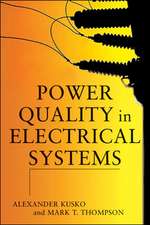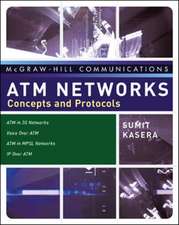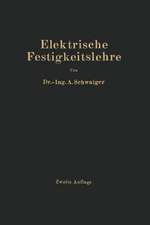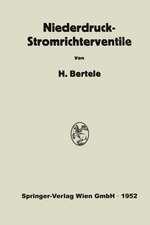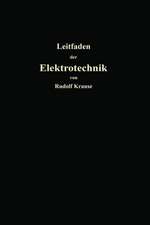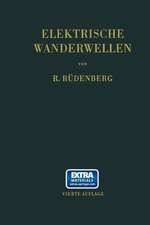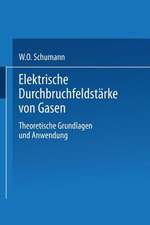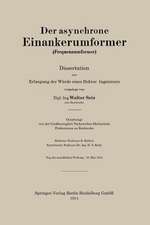Designing, Building, and Testing Your Own Speaker System with Projects
Autor David Weemsen Limba Engleză Hardback – 16 ian 1997
Preț: 155.03 lei
Preț vechi: 223.80 lei
-31% Nou
Puncte Express: 233
Preț estimativ în valută:
29.67€ • 32.24$ • 24.94£
29.67€ • 32.24$ • 24.94£
Carte tipărită la comandă
Livrare economică 24-29 aprilie
Preluare comenzi: 021 569.72.76
Specificații
ISBN-13: 9780070694293
ISBN-10: 007069429X
Pagini: 223
Dimensiuni: 185 x 231 x 17 mm
Greutate: 0.49 kg
Ediția:Revised
Editura: McGraw Hill Education
Colecția McGraw Hill TAB
Locul publicării:United States
ISBN-10: 007069429X
Pagini: 223
Dimensiuni: 185 x 231 x 17 mm
Greutate: 0.49 kg
Ediția:Revised
Editura: McGraw Hill Education
Colecția McGraw Hill TAB
Locul publicării:United States
Cuprins
Introduction
1 How a Speaker Works
Parts of a Speaker
Frequency Response
Transient Response
Dispersion
Cone Resonance
Compliance
Damping
Impedance
Efficiency
Power Rating
Speaker Polarity
Kinds of Drivers
2 Kinds of Speaker Enclosures
Functions of Enclosures
Types of Enclosures
Which Enclosure is Best?
3 Speaker-Box Construction
Desirable Enclosure Characteristics
Enclosure Shape
Speaker Placement
Some Recent Trends in Enclosure Design
Materials
Extra Wall Treatment
Construction Rules
Finishing Your Speakers
More Box-Construction Hints
4 Closed-Box Speaker Systems
Closed-Box Basics
How to Fit Box Volume to Speaker
Closed-Box Summary
5 Ported-Box Speaker Systems
Kinds of Ported Enclosures
How Tuning Affects Response
How Box Volume Affects Response
Thiele Ported-Box Design
Obtaining the Box and Port Dimensions
Fine Tuning by Ear
The Boom-Box Alignment
The Double-Chamber Reflex
How to Design a Double-Chamber Reflex
Band-Pass Systems
6 Crossover Networks
Kinds of Crossover Networks
How to Choose Crossover Frequencies to Match Drivers
How to Make a Choke Coil
L-Pads
Real World Crossovers
Where to Put a Crossover
Impedance Equalizers
Contour Networks and Notch Filters
Resonant-Peak Filters
Crossover Networks and Piezoelectric Tweeters
7 Fun with a Computer Program
Short Computer Programs
LDP
Programs for Driver Tests
Programs for Box Design
Programs for Box Tests
Programs for Network Design
Programs for Speaker Directivity
8 How to Choose and Use Your Speakers
Choosing a Speaker
Using Your Speakers
Kind of Wire
Terminals
How to Solder
Your Listening Room
Ideal Speaker Placement
Balancing Your Speakers
Protecting Your Speakers
Extension Speakers
9 Testing Your Speakers
Listening Tests
Critical Listening
Tests with a Sound-Level Meter
Frequency Correction with an Equalizer
Polarity Tests
Damping Test
Using Test Equipment
Impedance
Free–Air Resonance
Driver Q
Tests for Vvs
Box Tests
Notch Filter Test
10 Projects
Project 1: A simple mini-speaker
Project 2: A low-cost closed-box speaker system
Project 3: A ported-box mini-speaker
Project 4: A ported-box compact speaker
Appendices
A Useful Formulas
Electrical Units Used in Speaker Circuits
Ohm’s Law for Speakers
Reactance and Resonance
Conversion Factors for Speaker Compliance
Speaker Formulas for Constant-Voltage Sound-Distribution Systems
Choosing Impedance-Matching Transformers
Useful Speaker-Design Formulas and Procedures
B Wire Data for Homemade Coils
C Computer Programs
D Mail-Order Houses
Glossary
Index
About the Author
1 How a Speaker Works
Parts of a Speaker
Frequency Response
Transient Response
Dispersion
Cone Resonance
Compliance
Damping
Impedance
Efficiency
Power Rating
Speaker Polarity
Kinds of Drivers
2 Kinds of Speaker Enclosures
Functions of Enclosures
Types of Enclosures
Which Enclosure is Best?
3 Speaker-Box Construction
Desirable Enclosure Characteristics
Enclosure Shape
Speaker Placement
Some Recent Trends in Enclosure Design
Materials
Extra Wall Treatment
Construction Rules
Finishing Your Speakers
More Box-Construction Hints
4 Closed-Box Speaker Systems
Closed-Box Basics
How to Fit Box Volume to Speaker
Closed-Box Summary
5 Ported-Box Speaker Systems
Kinds of Ported Enclosures
How Tuning Affects Response
How Box Volume Affects Response
Thiele Ported-Box Design
Obtaining the Box and Port Dimensions
Fine Tuning by Ear
The Boom-Box Alignment
The Double-Chamber Reflex
How to Design a Double-Chamber Reflex
Band-Pass Systems
6 Crossover Networks
Kinds of Crossover Networks
How to Choose Crossover Frequencies to Match Drivers
How to Make a Choke Coil
L-Pads
Real World Crossovers
Where to Put a Crossover
Impedance Equalizers
Contour Networks and Notch Filters
Resonant-Peak Filters
Crossover Networks and Piezoelectric Tweeters
7 Fun with a Computer Program
Short Computer Programs
LDP
Programs for Driver Tests
Programs for Box Design
Programs for Box Tests
Programs for Network Design
Programs for Speaker Directivity
8 How to Choose and Use Your Speakers
Choosing a Speaker
Using Your Speakers
Kind of Wire
Terminals
How to Solder
Your Listening Room
Ideal Speaker Placement
Balancing Your Speakers
Protecting Your Speakers
Extension Speakers
9 Testing Your Speakers
Listening Tests
Critical Listening
Tests with a Sound-Level Meter
Frequency Correction with an Equalizer
Polarity Tests
Damping Test
Using Test Equipment
Impedance
Free–Air Resonance
Driver Q
Tests for Vvs
Box Tests
Notch Filter Test
10 Projects
Project 1: A simple mini-speaker
Project 2: A low-cost closed-box speaker system
Project 3: A ported-box mini-speaker
Project 4: A ported-box compact speaker
Appendices
A Useful Formulas
Electrical Units Used in Speaker Circuits
Ohm’s Law for Speakers
Reactance and Resonance
Conversion Factors for Speaker Compliance
Speaker Formulas for Constant-Voltage Sound-Distribution Systems
Choosing Impedance-Matching Transformers
Useful Speaker-Design Formulas and Procedures
B Wire Data for Homemade Coils
C Computer Programs
D Mail-Order Houses
Glossary
Index
About the Author



